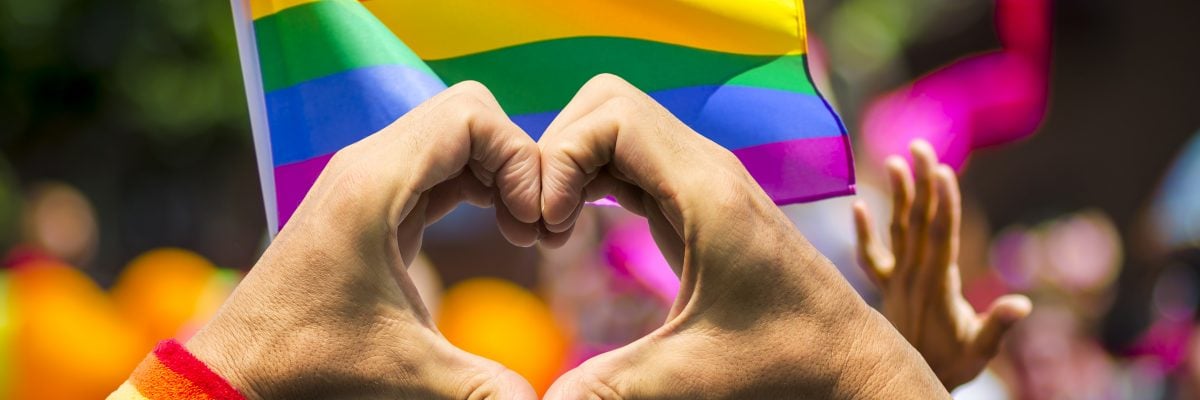
In the wake of the recent Orlando nightclub attack, many people, including Christians, have superimposed a rainbow flag over their social media profile pictures. In fact, this has become a common response to any perceived injustice against those who identify as LGBT. But should Christians promote this symbol, even as a response to tragic, unacceptable violence?
A symbolic victory
Before Christians associate themselves with any particular symbol, even to show solidarity with victims of violence, they must be familiar with the symbol’s meaning. Nothing, not even compassion for the victimized, can justify promoting a message that is at odds with the gospel.
For example, would an act of violence committed against a group of Satanists make it appropriate to put their version of the pentagram on our social media profiles? No, because even though it would be wrong to violently attack that group of people, there are other ways to show support for these victims without promoting a symbol associated with demons and blasphemy.
At this point some people, incapable of understanding an argument from analogy, may say, “He’s comparing the LGBT community to Satanists!” No, I am simply saying it’s possible to condemn an act of violence without promoting the ideology of the victims or promoting a symbol that embodies that ideology.
Now, one could raise a counterexample: “Would you object to putting a star and crescent moon on your social media profile in solidarity with a Muslim community that has been the victim of a recent tragedy?” Personally, I would show empathy to any religious group that was the victim of a tragedy, but I would not promote their religious symbol to achieve that goal.
Sharing a nation’s flag doesn’t contradict the gospel, because generally (though not always) one can be loyal to a country without sacrificing one’s loyalty to Christ (see Mark 12:17). But just as a Muslim would be uncomfortable adorning himself with a cross even for non-Christian philanthropy (which is why Muslim humanitarians organize under the Red Crescent and not the Red Cross), I would not be comfortable sharing a symbol that leads people away from Christ.[i]
Over the rainbow
This brings us to the rainbow flag, which is not a neutral identifier of a group of people but a symbol that promotes a worldview that is incompatible with the Catholic Faith. One example of a symbol a Christian could support would be the French flag, which many people posted on social media after last year’s Paris terror attacks.
Now, it’s true the French flag could be interpreted to refer to certain French policies that some might take issue with, just as the American flag can have positive and negative connotations among different audiences. But most people identify the French flag with a group of people rather than with a specific ideology (this may not be true for all national flags, but it is true for most of them).
The rainbow flag, on the other hand, symbolizes not just the diversity among those who identify as LGBT but the pride this group claims in the one thing that unites all of them: their sexual behavior. The rainbow flag promotes not just pride in this behavior but the desire to take action to legally silence or publicly shame those who would disagree with it. According to one California university website that describes “safe zones” and the symbols one would find in them, “the International Flag Makers Association has recognized [the rainbow flag] as the official flag of the LGBTIQ civil rights movement.”
In fact, the first color on the original rainbow flag was hot pink and symbolized sexuality. The other colors were red (life), orange (healing), yellow (sunlight), green (nature), turquoise (magic/art), indigo/blue (serenity/harmony), and violet (spirit). Given its free-spirit and nature themes, it probably won’t surprise you to learn the rainbow flag was the creation of a self-identified gay man named Gilbert Baker who grew up in the 1960s.[i]
By 1979, the flag dropped the hot pink color, because the necessary fabric was too expensive and rare for mass production. The turquoise and indigo bars were later blended together into blue to give the flag an even number of bars that could be easily hung in San Francisco pride parades.
Have Courage
Here’s another example to show that the flag’s message is about sexual values. I’m sure that most LGBT activists would be upset if Courage, the Catholic apostolate that promotes chaste living among those who identify as LGBT, were to fly the rainbow flag. The activists would probably say the flag belongs not just to those who have an LGBT orientation but to those who take pride in this orientation and see nothing wrong with engaging in homosexual or transgender sexual behavior.
Indeed, this narrow view of the human person that equates deep-seated attractions with unique personal identity is why a group like Courage would not fly the rainbow flag. The symbol Courage does identify with is the crucifix, because even though our sexual attractions and behaviors may change over time, it is always true that believers are redeemed children of God, and this should represent the core of our self-identity.
We should show support for those who are the victims of violence, even if they promote anti-Catholic values. We should do this even for outspoken enemies of the Faith (see Matthew 5:44). But we should not associate ourselves with symbols that are widely recognized to stand for something that is contrary to the deposit of Faith given to us by Christ and the apostles.
___________________________
Notes
[i] In fact, Muslim countries refused to cooperate with the Red Cross when they attempted to incorporate Israeli humanitarians under the Red Star of David. A compromise was reached in 2005 with Israel being allowed to use a Red Crystal emblem.
[i] Baker admits that the popular 1960s “flag of the races” inspired his rainbow flag. The rainbow theme may also have been inspired by Judy Garland’s song “Over the Rainbow” due to her status as a gay icon.



